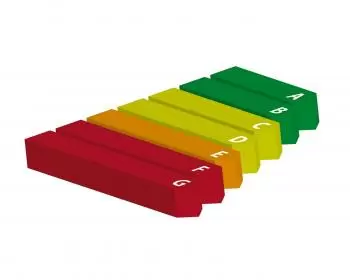
We define the efficiency of photovoltaic panels as the proportion of the amount of solar energy converted into electrical energy through photovoltaic energy.
Currently, the average conversion efficiency of photovoltaic panels is between 16-17%. Solar panels with values higher than 19% are considered high-efficiency panels. Most residential solar panels have power output ratings from 250 to 400 watts.
The efficiency rate of the solar panels, the latitude, and the climate are the elements that determine the amount of sunlight that is converted into electricity. As in all renewable energies, this factor is vital to decide on the economic viability in the long term of a solar system.
Photovoltaic energy is a type of clean energy based on the impact of photons of light on photoelectric cells generating an electric current.
When we refer to the conversion efficiency of this type of solar panel, we are implicitly referring to:
-
Thermodynamic efficiency
-
Charge carrier separation efficiency
-
Reflectance efficiency and driving efficiency values.
These parameters are difficult to measure directly, so other parameters are measured instead, including quantum efficiency, open-circuit voltage ratio, and fill factor.
How to improve the efficiency of solar panels?
The following technical methods will make solar panels more efficient:
1. Solar panel cooling
Temperature influences the performance of a solar panel. This variation is quantified by the temperature coefficient, expressed as the percentage decrease in production for each increase of 1 degree Celsius from 25 degrees Celsius.
For each degree centigrade that the cell temperature increases, the solar efficiency decreases by about 0.45%. We can avoid the decrease in solar efficiency due to heating using a visibly transparent silica glass layer applied to a photovoltaic solar panel.
The silica crystal layer acts as a thermal black body that emits heat in infrared radiation into space. With this action, it is possible to lower the temperature of the photovoltaic cell up to 13 degrees Celsius.
2. Promoting the dispersion of light in the visible spectrum
By lining the cell's light-receiving surface with nano-sized metal posts, the efficiency of the cell can be increased substantially. Solar radiation reflects off these posts at an oblique angle to the cell.
This change in direction causes an increase in the length of the path that the light takes through the solar cell. Consequently, increasing the course increases the number of photons absorbed by the cell and the direct current generated.
3. Choose the optimal transparent conductor
The bright side of some types of solar cells has a transparent conductive film that allows sunlight to enter the active material and collect the generated charge carriers.
Generally speaking, films with high transmittance and high electrical conductance are used for this purpose. However, there is a trade-off between high transmittance and electrical conductance, so the optimal density of conductive nanowires or conductive network structure must be chosen to increase efficiency.
4. Use anti-reflective coatings and textures on the solar panel
Anti-reflective coatings could result in more destructive interference from incident light waves from the sun. Therefore, all the sunlight would be transmitted to the photovoltaic system.
Texturing is another technique to reduce reflection. With this technique, the solar cell’s surface is altered so that reflected light hits the surface again.
5. Thin film materials in solar cells
Some solar panel manufacturers use thin-film materials in their solar modules to get higher efficiency.
In terms of low costs and adaptability to existing structures, thin-film materials improve the energy harvesting of photovoltaic cells.
However, because the materials are so thin, they lack the optical absorption that bulk material solar cells have.
6. Passivation of the posterior surface
The aluminum back surface slows down improvements in solar efficiency. However, the efficiency of many solar energy systems has been improved by creating so-called passive and passive heat-emitting cells.
Chemical deposition of a stack of dielectric passivation layers from the back surface helps improve efficiency in silicon solar cells by more than 1%.
On what does the efficiency of a solar panel depend?
The efficiency of solar panels on the market depends mainly on two:
-
The efficiency of the photovoltaic cell: the efficiency of the cell is based on its design and the type of silicon that can be of high purity or not. Monocrystalline silicon has the highest efficiency. Its system efficiency is around 27% in the standard test conditions.
-
The total efficiency of the panel. It depends on the design of the solar cell and the configuration and size of each type of photovoltaic panel. These values can be obtained from the technical sheet of the solar panel.


